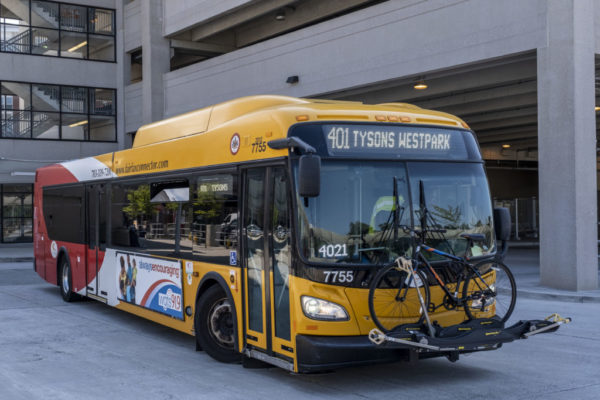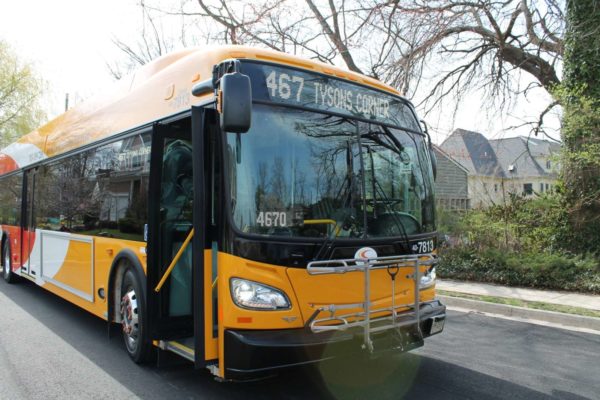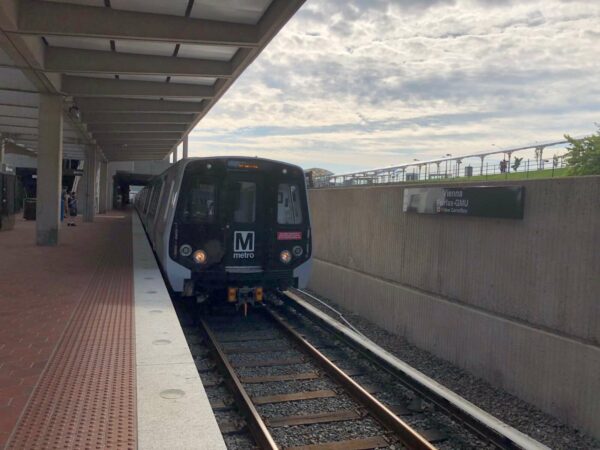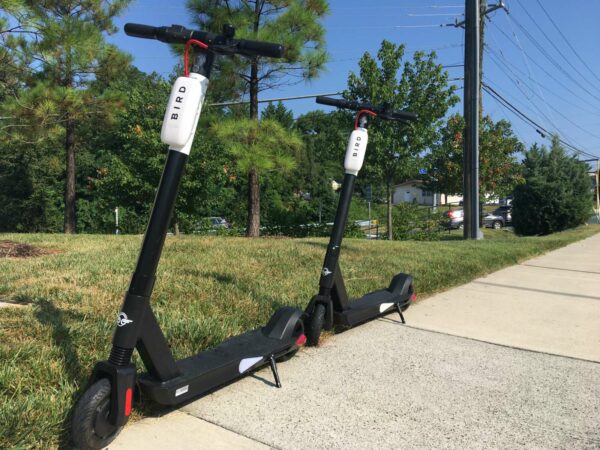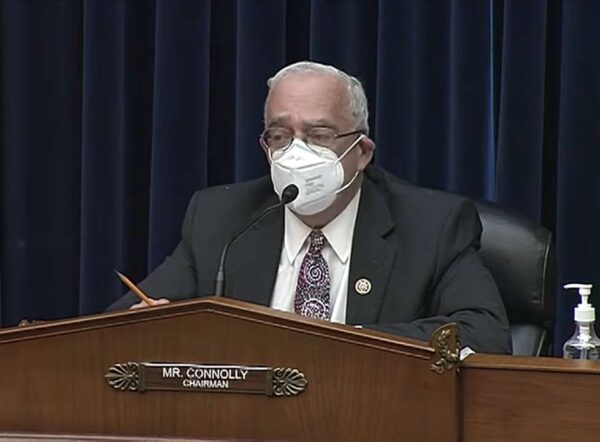
(Updated at 10:10 a.m.) Tysons got a shoutout yesterday (Wednesday) from Rep. Gerry Connolly (D) at the Congressional hearing on Metro.
Connolly called the hearing before the House Subcommittee on Oversight and Reform, which he chairs, in December to address the safety issues that have sidelined more than half of the transit system’s trains for nearly three months now after a derailment in Arlington.
The two-hour hearing primarily featured Washington Metropolitan Area Transit Agency leaders addressing questions about the prolonged effort to fix the 7000-series trains, ridership declines, and a looming budget shortfall with federal relief funds running out.
However, it also saw Connolly defend the investments made to bring Metro into Tysons and Reston. The first phase of the Silver Line opened in 2014, after Connolly assumed office in Congress, but the groundwork for the $2.9 billion project was laid while he served on the Fairfax County Board of Supervisors.
Asked whether the D.C. area has the density to support Metro, witness David Ditch, a policy analyst for the conservative Heritage Foundation, suggested local governments should privatize rail or shift resources to buses, which he argued are “more economical” since they “share road infrastructure.”
“When you’re in a hole, stop digging,” Ditch said. “Past spending on transit infrastructure is not a justification for ignoring high costs and limited benefits or adding even more high-cost infrastructure on top of what we already have.”
Connolly countered that federal and local officials “experimented with” a variety of options for the Silver Line, including the inclusion of a bus rapid transit system as part of the project. Fairfax County launched an express bus service in the Dulles corridor in 1999.
However, he said the buses saw a third or less of the ridership of the existing Metro trains, indicating that rail would be the better investment.
He pointed to Tysons as an illustration of how transit can spur economic development, drawing more residents and businesses that will sustain the system long term, at least if Fairfax County’s comprehensive plan pans out.
“When we built the Silver Line through Tysons, we had 17,000 people live in Tysons, a physical area bigger than downtown Boston,” Connolly said. “Because of the advent of rail, there’ll be 100,000 additional residents in Tysons. The density, in some cases, is dependent on the investment in rail, and I believe Tysons is a great example of a potential success story.”
Unmentioned during the hearing was that plans for bus rapid transit in Tysons are in the works, though the proposed system will be tied to Route 7, rather than the Silver Line.
The Fairfax County Board of Supervisors is also scheduled to approve plans to enhance bus service in Reston and Herndon later this month, as Metro prepares to open the Silver Line’s second phase this spring after years of delays.

Several companies in the Tysons area have earned bragging rights for their efforts to reduce vehicle trips.
The University of South Florida’s Center for Urban Transportation Research announced its annual lists of the Best Workplaces for Commuters and Best Sites for Commuters on Thursday (Jan. 27), recognizing employers and urban projects across the country that promote transit, carpools, vanpools, and telework.
“Receiving this designation is a significant accomplishment,” Best Workplaces for Commuters program manager Julie Bond said in a press release. “Employers named to the list demonstrate a strong commitment to their employees by providing outstanding commuter programs, like telework, discounted transit passes, bicycle-friendly amenities, rideshare solutions, and emergency ride home programs.”
Awardees in the immediate area includes the following:
- ActioNet
- Archer Hotel Tysons
- Bart & Associates
- Citizens’ office at Fairview Park
- Cvent
- FH+H
- Hilton McLean Tysons Corner
- IronNet Cybersecurity
- KeyLogic
- KPMG
- QOMPLX
- Ross, Langan & McKendree
- Slalom
- SpinSys
- Strategic Resources, Inc.
- The Boro (Best Site)
- The MITRE Corporation
- Towers Crescent (Best Site)
- Tyson Corner Center’s Access Tysons concierge service (Best Site)
- Wells + Associates
The first Best Workplaces for Commuters list was unveiled in 2002 by the Environmental Protection Agency and U.S. Department of Transportation as an outgrowth of a federal commuter choice initiative started in 1999, according to the program’s website.
The Center for Urban Transportation Research took over the program in 2007.
To get the designation, employers must meet environmentally friendly standards and pay membership dues.
According to its website, workplaces must meet criteria across three tiers.
To qualify, an employer must offer one primary benefit, such as employer-paid tax-free transit or vanpool passes, teleworking, bicycling or parking cash-out (enabling workers to trade free parking for its cash equivalent).
Other standards, such as supporting benefits and commitments, must also be met.
There’s flexibility for how those standards are met, though, so if a place doesn’t have bicycle racks or shower facilities, it could still fulfill the criteria with other benefits, such as bus stop amenities and an on-site business center.
The Best Sites designation is for commercial developers, shopping malls, corporate campuses, and other developments with multiple employers.
If someone wanted to take a bus from Tysons to Springfield right now, they would have to sit through dozens of stops to travel the roughly 15 miles from north Fairfax County to the south.
The Fairfax County Department of Transportation hopes to change that by adding a 400X express route that would travel between the Tysons and Franconia-Springfield Metro stations via Gallows and Backlick roads.
Among the busiest corridors in the county, Gallows and Backlick are currently served by Fairfax Connector Routes 401 and 402, but even though they span a sizable area, those routes provide more localized service with frequent stops.
“With over 100 stops on this route, passengers traveling longer distances may have a slower trip,” Fairfax County Department of Transportation spokesperson Robin Geiger said by email. “The limited stop 400X bus route addresses this issue by significantly reducing travel time in the corridor between Tysons and Franconia-Springfield.”
The Fairfax County Board of Supervisors voted on Sept. 14 to approve Route 400X as one of seven projects recommended for funding from the Northern Virginia Transportation Authority for fiscal years 2022-2027.
Compared to the “Ring Road” project at Seven Corners, which was also in the $620 million package, the $10 million requested for the new Connector route is modest, but it would buy eight new buses, covering the entire estimated cost of the proposal.
As envisioned by the county, the new express route would provide bus service between the Tysons, Dunn Loring-Merrifield, and Franconia-Springfield Metro stations during peak hours, with a peak frequency of 20 minutes, according to FCDOT staff.
In addition to speeding up Connector trips between Tysons and Springfield, the proposed route would increase access to those areas from Annandale and help Metrorail riders who currently have to leave the county to transfer between the Orange, Blue, and Silver lines, Geiger says.
FCDOT has recommended adding a limited-stop route to enhance capacity on Routes 401 and 402 since at least 2009, according to the county’s 2016 Transit Development Plan.
According to the plan, which recommends transit improvements for fiscal years 2016-2022, Fairfax Connector increased the frequency of its service on those routes in 2014 when the first phase of Metro’s Silver Line opened, but trips can still take as long as 100 minutes during peak travel times.
With more than 108,604 people living in the I-495/Gallows Road corridor and over 176,800 jobs located there, Route 400X is part of a Franconia-Springfield bus service review that FCDOT conducted last year to see how Fairfax Connector could evolve to accommodate the area’s anticipated growth.
“This 400X route will address future travel demand in the corridor through a multi-modal response that enhances connectivity,” Geiger said, noting that the county also plans to expand Capital BikeShare and add bicycle routes. “…The route will also benefit from its connection to the Tysons Circulator routes that distribute trips to employment centers in the Tysons area.”
The review overlaps with a similar evaluation of the Tysons area that proposes several new and modified routes. Both studies will be incorporated into a Transit Strategic Plan that FCDOT is developing and expects to be adopted by the Board of Supervisors in 2022.
“If funded and approved by the Board of Supervisors, [Route 400X] is anticipated to become operational in 2023,” Geiger said.
The Fairfax County Department of Transportation has extended the Oct. 18 deadline for its community survey on proposed changes to bus service in Centreville, Chantilly, Vienna, Tysons, and neighboring areas, including McLean and Falls Church.
The online survey, which is available in English and Spanish, will now be open until next Wednesday (Oct. 27).
Unveiled at virtual public meetings on Sept. 30 and Oct. 7, the preferred plan will enable Fairfax Connector to serve more people, reduce travel times, maintain more reliable schedules, and provide more access to key destinations in the area, according to FCDOT.
“We encourage people to take the survey so they can tell us what is most important to them in the preferred bus plan for the Centreville, Chantilly, Vienna and Tysons areas,” FCDOT Transit Planning Chief Michael Felschow said. “The service belongs to our riders and our goal is to make it dependable, convenient and on-time.”
Fairfax Connector launched its review last year as part of a broader effort to identify service improvements that could be made throughout the transit system. So far, the evaluation has also included looks at the Franconia-Springfield area as well as Reston and Herndon.
County officials initially presented three possible plans: one similar to existing service patterns, one that completely overhauled the service area, and a hybrid. The preferred plan now under consideration is the product of revisions based on community feedback.
The proposed plan encompasses 24 bus routes, including several involving the Tysons area:
- Route 427 (North Tysons-Spring Hill): A new route between the Spring Hill Metro station and the McLean Governmental Center area, via Jones Branch Drive and Spring Hill Road
- Route 468 (Vienna-Reston): A new route between the Vienna and future Reston Town Center Metro stations, via Lawyers and Soapstone roads
- Route 660 (Centreville-Tysons): New, direct express service between the Centreville Park & Ride on Stone Road and the Tysons Metro station, via the Vienna station and I-495 Express Lanes
- Route 662 (Centreville-Vienna): New off-peak and weekend service between the Centreville Park & Ride and the Vienna Metro station, via I-66
- Route 671 (Chantilly-Vienna): New off-peak and weekend service with limited stops between Chantilly and the Vienna Metro station, via Route 50
- Route 722 (McLean-Langley): A new express route between the McLean Metro station and Langley, via Route 123/Dolley Madison Boulevard
Some existing routes in the plan will have better connectivity or more frequent service, such as Route 467 between Dunn Loring and Tysons and Route 461, which travels in a loop through Vienna and Oakton.
A full breakdown of the routes and service maps can be found on FCDOT’s website.
Fairfax Connector is also studying a “flex service concept area” in Vienna and McLean northwest of Route 123 “as a way to provide future on-demand service to and from the four Metro Stations within Tysons,” according to a map showing the preferred plan’s peak service routes.
According to FCDOT, the preferred plan will shave about a minute off the average travel time within the review area compared to its existing Connector service. It will also put an additional 2,700 people within a quarter-mile of the bus system.
The changes will provide more service to population and job centers as well as minority communities and households with an income at or below $50,000, according to the county.
Along with filling out the online survey, community members can also provide input by phone (703-877-5600), email ([email protected]), and mail (Fairfax County Department of Transportation, 4050 Legato Road, Suite 400, Fairfax, VA 22033).
Metro is no stranger to safety challenges.
Last week’s train derailment in Arlington was just the latest in a long history of perilous, occasionally fatal incidents that have plagued the D.C. region’s primary transit system, from track fires and smoke-filled tunnels to the Red Line crash that killed nine people in 2009.
While no injuries were reported from the derailment, the ensuing investigation disrupted rail service on the Blue, Orange, and Silver lines throughout the week.
Initial findings of that investigation are now in, and they could be a devastating blow to the Washington Metropolitan Area Transit Authority’s campaign to lure passengers back after the COVID-19 pandemic sent ridership tumbling last year.
Metro pulled nearly 60% of its fleet out of operations Sunday night (Oct. 17) after the National Transportation Safety Board uncovered wheel axle defects on multiple 7000-series trains, which were introduced in 2015. The federal agency reported today (Monday) that these issues have occurred at least 31 times since 2017, including twice on the derailed car before it actually went off the tracks.
With use of the 6000 trains already suspended due to recent car separations, Metro was left with just a few dozen trains today and reduced service to just one six-car train every 30 minutes, resulting in crowded trains, platforms, and buses.
And as promised, #wmata is running shorter 6-car trains every 30 minutes, all day today. The 7000's and most of the 6000's are out of service. pic.twitter.com/ApnROBBbGn
— Metro Reasons (@MetroReasons) October 18, 2021
While WMATA hasn’t announced its upcoming service plans yet, it seems like a safe bet that the challenges facing the transit system won’t be solved overnight.
Metro says they plan to have more service information out within the next few hours.
But that being said, this region is in big trouble if this is a months-long issue. https://t.co/oiMAXGkMZl
— Jordan Pascale (@JWPascale) October 18, 2021
How will Metro’s safety issues and new service limitations affect your travel plans going forward? If you were a regular rider, will you continue that habit or seek alternatives when possible?
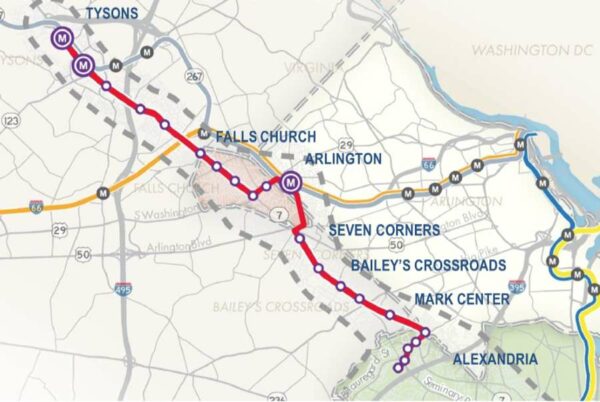
A regional study of the proposed bus rapid transit (BRT) route from Tysons to Alexandria is moving into a new phase that will assess options through the Seven Corners area.
The Northern Virginia Transportation Commission voted last night (Thursday) to approve a contract for the fourth phase of its Envision Route 7 mobility analysis study, which began in 2013 to evaluate the possibility of bus service between the Spring Hill Metro station and Alexandria’s Mark Center.
The Fairfax County Board of Supervisors gave their support to NVTC’s plans to continue the study in February and approved a recommended route for the Tysons segment of the BRT line in July.
“As we look to the corridor in segments, Fairfax has done a lot of work from Tysons to the border of Falls Church,” NVTC staff said at yesterday’s meeting. “This picks up on the analysis they’ve done and continues down to Seven Corners.”
The study is expected to take up to 18 months, ending in April 2023. It will be followed by environmental and preliminary engineering design before staff comes back with a strategic framework for the plan. The contract was approved with a $516,800 cap.
According to a report prepared for the meeting:
The Envision Route 7 Phase IV-1 Mobility Study will evaluate and determine the mobility benefits and impacts resulting from the proposed Bus Rapid Transit (BRT) from Tysons to Seven Corners. The overall study objectives for this effort for the section of Route 7 from Tysons to Seven Corners are:
- To determine the mobility benefits of BRT along Route 7;
- To gain a better appreciation of the traffic impacts of BRT along Route 7;
- To gain an understanding of the traffic operational issues with a BRT operating along
Route 7; and,- To facilitate the public understanding of how a BRT would operate along Route 7.
With the 11-mile Route 7 corridor expected to see a 35% growth in population and jobs by 2040, NVTC anticipates that the planned BRT will generate about 30,000 boardings per day, two-thirds of which will be for shopping and recreation, according to the project webpage.
The project is part of a larger effort to create a regional BRT network, with services also planned for Alexandria’s West End and Richmond Highway in Fairfax County.
Photo via Northern Virginia Transportation Commission
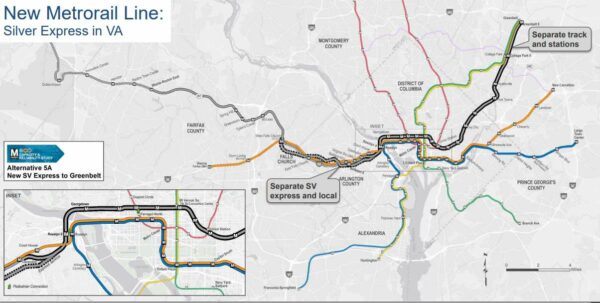
Metro has some bad news for fans of a proposed “Silver Line Express” rail service.
A recent cost-benefit analysis by the Washington Metropolitan Area Transit Authority (WMATA) found the project had the lowest cost-effectiveness of the five options being considered to boost capacity and reliability on the Blue, Orange, and Silver lines.
The hypothetical “Silver Line Express” would run through a new tunnel and tracks starting at the West Falls Church Metro station out to a second Rosslyn station in Arlington. The new tunnel could support express service, local service, or some mix of the two, a WMATA report said.
But a WMATA report and discussion at a Metro Board of Directors meeting on Thursday (Sept. 9) indicated the Silver Line Express may never leave the hypothetical stage. The cost-benefit analysis most heavily favored a new Blue Line route down from Union Station down to National Harbor.
The Silver Line Express carries an estimated cost of $20-25 billion, about the same as a new Blue Line route, but the report indicated that the express line would generate fewer new weekday trips — 139,000 compared to 180,000 for the new Blue Line — and receive less in annual fare — $119.4 million versus $154.2 million.
“When you look at the performance, the new Blue Line to national harbor offers highest impacts and highest benefits while lower cost alternatives have fewer benefits,” Mac Phillips, a principal planner and senior transportation economist-analyst for WMATA, told the Metro Board.
A cost-effectiveness ranking of the projects found the Silver Line Express to be the least cost-effective proposal, and only sitting at “medium-high” in terms of benefits.
Other options to expand capacity and ridership proposed by the study, which launched in 2019, include realigning the Blue Line at the second Rosslyn station to Greenbelt in Maryland and separating the Orange and Silver lines at Clarendon to create a second Silver Line connection at the proposed new Rosslyn station.
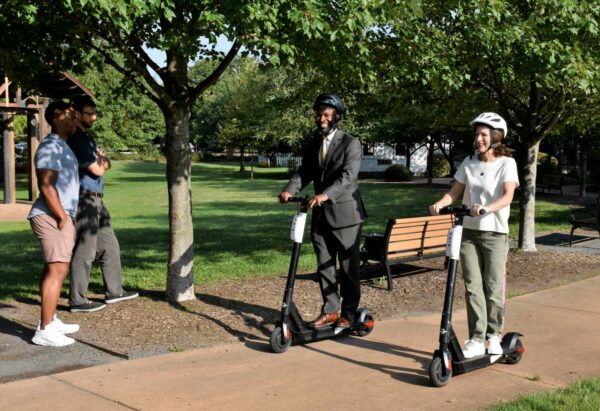
Vienna residents will soon be able to zip from one end of Maple Avenue to the other via electric scooter.
The e-scooter operator Bird will deliver 25 to 50 of the rentable devices beginning early next week as the first participant in a one-year pilot program approved in December 2019, the Town of Vienna announced on Wednesday (Sept. 8).
The scooters are now operational and got their first workout on the Town Green when Vienna Mayor Linda Colbert and Town Manager Mercury Payton conducted a test run Wednesday morning.
“The operation is pretty straightforward, and it seems very user-friendly,” Colbert said.
Payton added that the scooters will provide “a low-cost and environmentally friendly” alternative for people to travel around the 4.4 square-mile town without jumping in their cars.
Vienna started developing a shared mobility device pilot program after Gov. Ralph Northam signed a law on March 22, 2019 that gave localities the authority to regulate the operations of companies that provide motorized scooters and skateboards for rent.
The law set a January 2020 deadline for localities to establish their regulations through a pilot program or ordinance.
According to a summary of Vienna’s program, the pilot was originally supposed to last from Jan. 1 to Dec. 31, 2020, but the town didn’t get any interest from potential operators until Bird applied, convincing officials to extend the timeline, Vienna Transportation Engineer Andrew Jinks says.
The program will now last until September 2022, one year after Bird’s scooters go into service. The company will submit monthly reports to the town with data on trips, customer usage, and any issues, including crashes, injuries, and complaints.
“Our SMD pilot is for one year during which time we will gather information about use, safety and other
details to present to the Town Council,” Jinks said. “The Town Council will use the report to inform the direction of a permanent Town SMD ordinance.”
Under the pilot program’s terms, companies can introduce up to 150 scooters initially with a one-year, $5,000 permit. They can add up to 25 more devices each month if they log at least three daily trips per scooter on average during the previous month.
Bird was required to submit an initial plan for the service area in which their scooters will operate and the locations where they’ll be deployed. The devices must be parked in the public right-of-way where they won’t obstruct pedestrian walkways, disability access, or certain town operations, such as snow removal.
The operator must address any violation of the parking regulations within two hours of getting a report from the town or community members, according to the memorandum of agreement.
The e-scooters will be available for use on streets, sidewalks, and shared-use paths from 4 a.m. to midnight every day.
Regulated using GPS technology, the scooters can travel up to 15 miles per hour on side streets but are limited to eight miles an hour on Maple Avenue, Nutley Street, and in the vicinity of schools, parks, and recreation centers.
Bird’s arrival in Vienna will fill a gap in the Tysons area’s e-scooter network. The company started operating in Fairfax County in late July. The county also approved Superpedestrian’s LINK for its shared mobility device program.
Electric scooters have arrived in Fairfax County.
The devices started appearing early last week after the county introduced the companies Bird and LINK as the first two vendors in its Shared Mobility Device program, which was established in 2019 after the Board of Supervisors approved regulations for motorized scooters and skateboards.
Prior to the COVID-19 pandemic, e-scooters had overtaken docked bicycles as the most popular form of shared transportation in the U.S. They have been embraced by some as a quirky, more environmentally friendly alternative to cars, particularly for short “first mile/last mile” trips, though research suggests more work needs to be done to make them truly sustainable and accessible.
The recent explosion in dockless e-scooters around the country spurred states and localities to start regulating the devices, partly in response to complaints that they clutter up sidewalks and pose safety hazards for pedestrians, particularly people with disabilities.
In Fairfax County, vendors are limited to an initial fleet of 300 scooters with an option to expand to 600 vehicles depending on demand. The scooters must have a maximum speed of 10 miles per hour and can be prohibited on sidewalks by signage.
The county also requires vendors to pay a $5,000 bond to cover potential clean-up costs, and users that leave scooters in places that block car or foot traffic could be hit with a misdemeanor and fines.
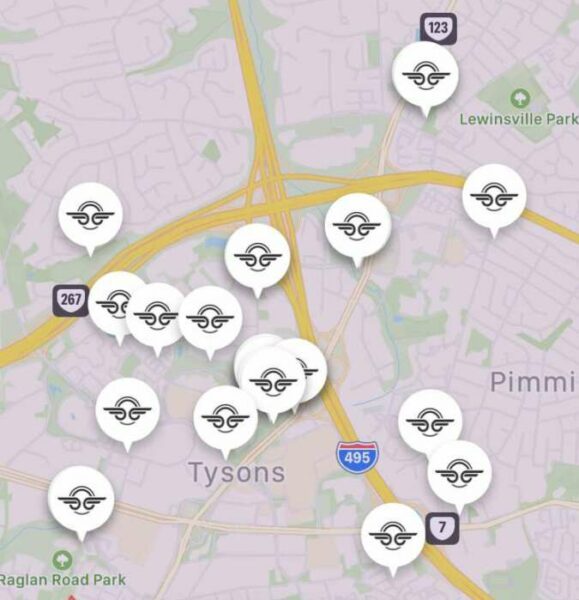
Now that e-scooters are here, how likely are you to use one? Are you excited to have this travel option, or do they seem like more of an obstacle than a convenience?
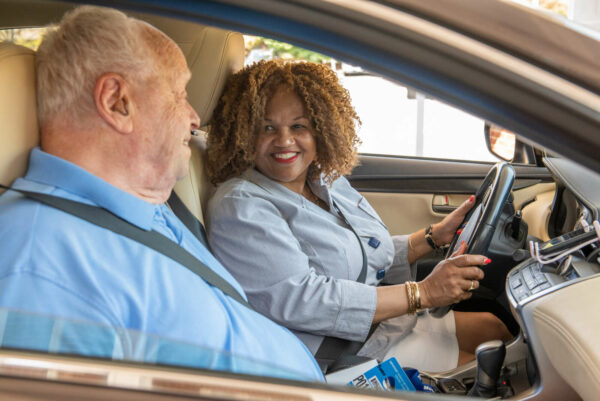
A program that connects elderly people in Northern Virginia with volunteer drivers needs a new manager.
NV Rides manager Jennifer Kanarek left her position in mid-July, Pozez Jewish Community Center (JCC) of Northern Virginia Executive Director Jeff Dannick said yesterday (Monday).
“We started this program a little over 7 years ago, and Jennifer was our first manager,” Dannick said, crediting Kanarek for helping build the program. “The community owes a great debt to Jennifer for her years of service.”
Housed at the Pozez JCC in Fairfax, NV Rides is a network of volunteer driver programs that formed in 2014 after a Fairfax County survey identified access to safe and reliable transportation as a top concern among the county’s older residents, a population that is expected to continue growing over the next two decades.
In its 2020 demographic report, the county projects that people 65 and older will constitute its largest age group by 2025, eventually making up 17.5% of the total population in 2040.
“I have learned so much over the last seven years and knowing the impact that the NV Rides program has had on vulnerable adults in our community is what gets me out of bed in the morning,” Kanarek said in a statement. “I have thoroughly enjoyed working with our community partners, stakeholders, and my staff in building, developing, and growing this crucial program.”
Kanarek announced that she was stepping down from her position with NV Rides last week, saying on her LinkedIn page that the decision comes with “mixed emotions.”
“I am proud of all I and my partners have accomplished, and I have made the decision to pursue other opportunities,” she wrote.
NV Rides consists of 15 partner organizations, ranging from local Shepherd’s Centers and religious organizations to Reston Community Center’s RCC Rides service, which has been suspended during the COVID-19 pandemic.
According to the NV Rides website, the network has provided close to 40,000 rides since it began.
“They’re not taxi drivers. They’re coming to help you get to your appointment. They’re coming to help you shop for groceries. So, it’s really a companionship piece,” Kanarek said in a July video about the program, noting that while many elderly people can use ride-hailing apps such as Lyft or Uber, there can be varying levels of trust with a paid stranger versus a volunteer.
According to Kanarek, NV Rides has looked to recruit younger drivers because the average driver has been around 67 years old, and they may not want to return when the pandemic subsides.
After seeing ridership decline when Virginia went under a stay-at-home order in the spring of 2020, Dannick says NV Rides has now returned to “around pre-COVID levels” for volunteer drivers.
In June, NV Rides partnered with the Reston-based Dulles Airport Transportation Association on an outreach effort to provide transportation to medical appointments for veterans in Fairfax, Loudoun, and Prince William counties.
The Pozez JCC is currently advertising for a long-term successor to Kanarek. The job posting lists the position’s annual salary as $45,000 to $55,000.
Meanwhile, the program’s interim manager is Tom Eversole, a retired naval officer who serves on the NV Rides Advisory Council.


